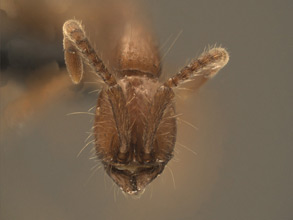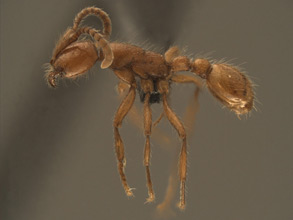- Identification
- Workers have a single eye facet and a short, thick scape. Among Neivamyrmex species, opacithorax workers differs from their congeners by having a mandible with a distinct tooth or sharp angle at the juncture with the masticatory margin and a relatively shiny head.
- Biology
- Neivamyrmex is a diverse genus that contains species that range from Argentina to Iowa. Colonies of Neivamyrmex opacithorax likely contain many tens of thousands of individuals. Like other army ants they do not live in a permanent nest but instead form temporary bivouacs. The colony coalesces in the same location, in the evening after a day of raiding, for a number of weeks. The bivouac site is eventual moved to a new location and daytime raids then occur from this new location. This species typically raids below ground but is occasionally seen using an above ground trail.
- additional biology notes...
- Distribution
- Range
- United States, Mexico, Central America. Costa Rica through Mexico, north to California, east through Arizona, New Mexico, Texas, Oklahoma, Kansas, Alabama, Arkansas, Missouri, Iowa, to Mississippi, Florida and north through Georgia, South Carolina, North Carolina, Tennessee and Virginia. The following map (Watkins, 1985) shows the species' range in the United States.
- Navajo Reservation Records
- Navajo Reservation: Bajada of Carrizo Mountains, Arizona. 1,930 meters elevation. Pinyon-Juniper Woodland.
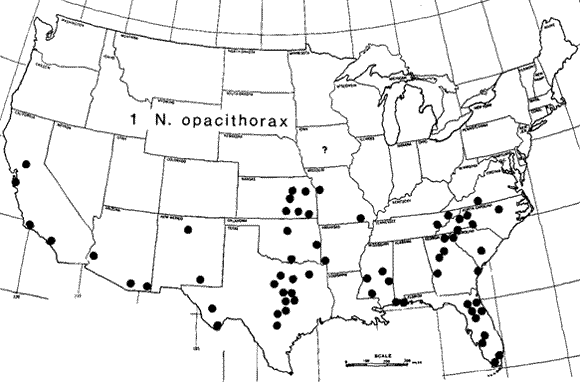
- Additional Notes:
- The following is based on Rettenmeyer (1963), with the references cited here detailed in the original publication.
- Neivamyrmex opacithorax has a range approximately equivalent to that of Neivamyrmex nigrescens in the United States, and in addition the former species extends southward to Costa Rica. Both species are found throughout most of the southern states from California to North Carolina and extend farther north in the plains states, Kansas, Nebraska, and Iowa (M. R. Smith, 1942: 558; Borgmeier, 1955: 504).
- There are a number of seemingly contradictory statements in the literature regarding the relative abundance of these two species. Cole (1953b: 84) reported that opacithorax was much more common in New Mexico than nigrescens. In the Gulf States, M. R. Smith (1942: 560) reported that opacithorax is "never so abundant as" nigrescens. Schneirla (1958a: 221) reported that in Arizona opacithorax is "perhaps as common" as nigrescens, but he also stated, "more than 12 colonies of Neivamyrmex nigrescens and 6 colonies of opacithorax were found . . ." ( p. 241 ) . Part of the above discrepancies may be explained by the report that nigrescens is more abundant in the southeastern United States compared with farther west (Creighton, 1950: 65). Perhaps of more importance are the precise habitats of the two species. In Kansas, opacithorax has been found in open fields, and in park-like areas within cities. Neivamyrmex nigrescens, on the other hand, has not been found in these areas but was found within more moist wooded areas. Although this conclusion has been based on a total of only about 15 colonies of the two species found in Kansas, it suggests that opacithorax may be restricted to drier areas throughout the country.
- Raids of Neivamyrmex opacithorax
- Neivamyrmex opacithorax appears to feed almost exclusively on ants and carabid beetles. The capturing of larval and adult Carabidae seems to be a common occurrence since three colonies of opacithorax in Kansas had killed numerous specimens, and Wheeler and Long (1901: 163) reported that opacithorax in Texas had captured "a considerable number of small carabid beetles.” Ants probably are more frequently killed in all localities, and ant larvae taken from raid columns showed no movement, probably indicating that they are killed by stings of the army ants at the time of capture. Workers from three colonies showed little attraction toward pecans, English walnuts or roasted peanuts, but two workers at one time chewed on a piece of walnut for about five seconds.
- Raids of opacithorax primarily occur in the evening, night and early morning. On cloudy days raids may be extended throughout the day, but the ants rarely raid in sunlight. In all cases the raids seen were column raids with no tendency toward swarm raids. On several but not all raid columns each incoming ant carried a piece of booty. It appears that opacithorax may be more efficient than the common species of Eciton in that fewer opacithorax workers return without prey. It is uncommon to see two or more workers of opacithorax carrying a single piece of booty, whereas such tandem carriers are frequent among Eciton spp. The column raids of opacithorax look inefficient at capturing prey since the ants do not run up low vegetation including even short blades of grass. Numerous insects retreat a few centimeters up on objects and completely escape the ants. The raid columns often show greater fluctuations in traffic than those of most army ants observed, but the fluctuations are not as great as those seen along raid columns of Neivamyrmex pilosus.
- Some additional information on the raiding of this species is given by Schneirla (1958a).
- Emigrations of Neivamyrmex opacithorax
- Three emigrations of opacithorax have been seen in Lawrence, Kansas. The first one found occurred on 3 June 1958 starting probably about 10: 00 p. m. When colony E-263 was first visited at 10:25 p. m. that night, there were no raid columns, and a steady emigration column extended from one hole in the ground to a second hole under a dense bush 50 cm. away. The exact location of the subterranean bivouac(s) is unknown, but since 26 May the ants had raided daily coming out of one or more of five holes within a radius of 16 cm. If one considers 26 May as the first statary day, the ants were emigrating on the ninth statary day or approximately the middle of the statary phase. From 10:25 until 11:10 p.m. the emigration column increased in width slightly until it was between three and five ants wide. No callows were seen in the column, and the brood being carried was in the egg stage. By 11:35 p. m. guard workers had positioned themselves along the column. Some of these became quite excited partly due to my collecting. In addition, a lycosid spider walked across the column, and a sowbug and a caterpillar started to walk across and retreated. The caterpillar was severely attacked; however, the other arthropods were not injured. The excited guard workers sometimes climbed as high as two centimeters up on vegetation, and sometimes ran about six centimeters out from the emigration column. At six minutes past midnight the physogastric queen came walking along the column. The column was highly aroused by that time, and there was no discernible wave of excitement due to the advance of the queen. It is possible that the queen had some difficulty getting through the hole in the ground which was just large enough for her to pass. A solid row of guard workers was along 50 cm of the epigaeic route, but these guard workers were not arranged in a compact wall or tunnel as had been observed with L. praedator and other army ants. The queen had about six workers on her in the emigration column, but these were riding and in no way helping her progress along the column. In spite of appearing to be in a maximally physogastric condition, the queen had no obvious difficulty running along the column. The workers of opacithorax, like those of other species of army ants, can run appreciably faster than the queen on a level surface. Most of the egg brood was carried before the queen was seen, but additional brood was carried up until about 12:28 a. m. By this time the number of guard workers had markedly decreased in number, but the width of the column remained approximately the same. By 12:34 a. m. all the guard workers had left, and occasionally a packet of eggs was carried by. Before the queen emigrated, one could see more than 25 packets of eggs along a stretch of column 30 cm. long, but by 12:34 a. m. a maximum of one packet per 30 cm. could be found. Between 12:40 and 12:51 a. m. the column got abruptly thinner, more ants seemed to hesitate and go back along the column a few centimeters, and the first two workers were seen being carried. Several ants were seen to walk more or less sideways, hesitating and picking up dirt and pieces of wood. These workers appeared to be a clean-up squad checking to see whether anything had been left behind. The behavior, which is not seen along the emigration column when it is thronged with actively moving ants, probably is responsible for the carrying of workers and guests more at the end of emigrations rather than during the beginning and middle periods. At 12:54 a. m. the last ants had passed. The end of this emigration made slow progress since the ants ran back along the column and also constantly ran five to ten centimeters laterally from the trail. The caterpillar which had been attacked about 11:40 p.m. was gradually abandoned during the last half hour of the emigration. It struggled constantly while the ants were attacking it and was unable to crawl when abandoned. Observations continued along the trail until 1:31 a. m.; and although no further ants passed, a few phorids and staphylinids were seen.
- In addition to the large number of eggs seen being carried on the emigration, the queen from the above colony laid about 9,500 eggs after she was taken. As far as could be determined she did not eat during this period. (More details of the oviposition are given below in the section Oviposition and Queens of Neivamyrmex opacithorax. ) The exact location of neither bivouac is known; but since the epigaeic emigration column was just 50 cm. long, it is highly probable that this was not a normal emigration. Similar short "emigrations" or bivouac shifts of E. hamatum and burchelli have been seen during the statary phase. However, the bivouacs of these two tropical species had been disturbed, and the bivouac sites in some cases had been completely destroyed. There was no known disturbance of the bivouac of this colony of opacithorax. The holes used by the ants were at the edge of a driveway, and it is possible that the bivouac was under the driveway and in too hot and dry a location for the ants. One colony of Neivamyrmex nigrescens emigrated during the statary phase when the queen was nearly maximally contracted, and this emigration was thought to be due to disturbance by a colony of Pheidole (Schneirla, 1958: 231-232; pers. com.)
- Not a single callow worker, pupa, or larva was seen in the emigration. Although Schneirla (1958a) has given good evidence to support the hypothesis that Neivamyrmex nigrescens has a nomadic-statary cycle homologous to E. hamatum, there is no comparable evidence for Neivamyrmex opacithorax. This emigration of colony E-263 was undoubtedly atypical since it occurred in the middle of the oviposition period. At that time one would expect a brood of pupae to be present, and perhaps the absence of this older brood was partially responsible for the unusual emigration. (It is unlikely that an entire pupal brood would have been carried by a subterranean route or remained in a subterranean bivouac while the rest of the colony emigrated on the surface.) It is highly improbable that the egg brood formed during the emigration on 3 June 1958 was the first brood of the year. Neiv. opacithorax has raids on the surface of the ground and can be found in clusters under stones in Lawrence, Kansas, at least as early as 10 April. Broods probably are not produced during the winter, and it is not known when the first eggs are laid in the spring.
- On the evening of 4 June about 18 hours after the queen of colony E-263 was taken there was no backtracking column at 6:20 p. m.; however, at 10:15 p. m. a column was going toward the old bivouac site but into a hole about 18 cm. closer to the new bivouac than the exit hole used on the emigration. Thus, the ants were not backtracking along the trail actually used on the emigration but were using a different route of an earlier raid column. A few workers occasionally stuck their heads out of the exit hole used on the emigration, but no workers formed a connecting column on the surface of the ground. Two workers which had been kept in the laboratory with the queen were placed along the backtracking column. There was an immediate wave of excitement followed by an increase in the number of workers along the column. On 5 June a backtracking column was still present, and no further observations were made.
- Another emigration (colony E-264) was watched on 6 July 1959 on the campus of the University of Kansas. A raid column had been seen crossing a sidewalk next to Snow Hall during the day at 11:30 a. m. and 12:40 p. m. At these times the ants were going out on the column at a rate of about 50 ants in one minute and six seconds. Less than ten percent of the number of ants going out were returning. By 7:15 p. m. the column had increased to 50 ants going out in ten to 20 seconds with less than five ants going toward the bivouac in the same interval. By 8:45 p. m. traffic was more steady at about 50 ants going out and nearly 12 going in during 12 seconds. Booty was first seen being carried out at 8:53 p.m., and by 8:56 p.m. larval brood was carried. At this time approximately two percent of the ants carried either booty or brood. However, at 9:02 p. m. the amount of brood increased markedly until about 507c of the workers were carrying brood, and the traffic had increased to its maximum of about 50 ants going out in five seconds. At 11:22 p. m. the ants became more excited, workers ran one to five centimeters away from the column along both sides, and many more workers ran back toward the old bivouac. The queen was taken at 11:41 p. m. Up until 1:35 a. m. on 7 July when observations were ended, the number of ants going toward the new bivouac remained at the maximal rate, and workers went back toward the old bivouac at about 25% of the outward rate. Many callows and a few minor worker pupae were seen in the emigration. Only dark workers were seen returning toward the old bivouac and carrying other workers.
- A strong backtracking column was found along the emigration trail between 10:00 a. m. and 1:00 p. m. on 7 July. The column consisted solely of dark workers running in both directions in approximately equal numbers. At 8:00 and 9:00 p.m. the traffic on the backtracking column was the same or slightly stronger. At 7:45 a. m. the following morning the traffic on the column had decreased from its previous strength at night, and the first callow was seen in the column. The column continued throughout the day, and the first brood or booty was seen being carried toward the old bivouac (of 6 July) at 7:00 p. m. The backtracking column persisted until 10 July when it was noticeably weaker at 10:00 a. m. compared to previous days at that time. On 10 July at 6:00 p. m. and the entire following day there were no longer any ants along the trail.
- A third emigration (colony E-266) was watched almost continuously from 9:00 p.m. to 3:20 a.m. on 19 to 20 August 1959. Throughout this period numerous callows were seen, and booty and a brood of worker larvae about three-fourths grown were being carried. The queen was not seen, and neither guard workers nor greatly excited running workers were seen, indicating that she probably had not emigrated before 3:20 a. in. On 20 August at 7:30 p. 111. there was a weak column of about one ant per ten centimeters (including the approximately equal traffic in both directions). This column had disappeared by the following morning, and it is impossible to determine whether it was a backtracking column (possibly followed by a continuation of the emigration) or a raid column. Similar columns along previous emigration routes have also been reported for nigrescens (Schneirla, 1958a), but such columns are not found or are rare among Eciton spp.
- Bivouacs of Neivamyrmex opacithorax
- All bivouacs of opacithorax which have been located were subterranean, and their exact positions and sizes are unknown. On five occasions in the vicinity of Lawrence, Kansas, clusters of opacithorax have been found under small stones. Each of these clusters was considered to be less than five per cent of the total colony. Similar "bivouacs" under stones mentioned by Schneirla (1958a) probably were not entire colonies. Brood was never found in any of the clusters in Kansas except for the adult males in colony E-267 discussed below. However, opacithorax like nigrescens probably brings at least part of its brood up from more subterranean bivouacs to areas under stones on the surface of the ground. These stones were all exposed to bright sunlight during the day, and an unusually high number of staphylinid beetles or mounds of loose dirt indicated that the ants had been much more numerous under each stone than they were at the time they were found.
- Oviposition and Queens of Neivamyrmex opacithorax
- The queen from colony E-263 in the laboratory laid 9,500 eggs within 42 hours of the time when she was taken from an emigration column. This rate of oviposition is 226 per hour or 3.8 per minute, judging from the few colonies which I have seen, the colonies and broods of opacithorax and nigrescens are essentially the same size. At the above oviposition rate it would take the queen almost seven days to lay a brood of 37,000 eggs. A brood of that size was considered to be average for Neiv. nigrescens (Schneirla, 1958a: 242- 243). However, it is known from observations on physogastric Eciton queens that when these queens are brought into the laboratory, they cease laying sooner than if left with their colonies. In addition, Eciton and Neivamyrmex queens become noticeably weak and often die within a few days in the laboratory. As a consequence the oviposition rate in a normal bivouac may be considerably higher. Records for the first 19 hours indicate that queen E-263 laid at a rate close to 300 per hour which is probably closer to the rate in a bivouac. At this rate she could have laid a brood of 36,000 eggs in five days.
- Actual egg laying occurred in irregular spurts with sometimes more than five minutes between two groups of eggs. The eggs most frequently were laid in groups of two to eight eggs stuck together at their tips. Five or six eggs usually were laid in 30 seconds. The eggs appeared moist when laid and readily stuck together in packets without licking or handling by the workers. The queen often rested partially on her side when ovipositing and frequently walked around the dish scattering eggs wherever she went. The workers gathered up most of the eggs and placed them in piles. Several workers ate some eggs while turning their abdomens under as if they were stinging the eggs at the same time. It is not known whether the workers also eat eggs or other brood in a bivouac, but it is a well-known fact that other Ecitonini eat their brood of all ages more readily in the laboratory than under field conditions.
- The queen was kept alive until 6:00 p. m. on 5 June 1958 when she was placed in Bouin's fixative. No eggs had been laid during the preceding hour, and only a few were laid in the last three hours before preserving the queen. As far as we could determine the queen did not eat nor drink anything while she was in the laboratory. The queen from colony D-175 taken by Howell V. Dalv from a cluster under a stone also was never seen to feed, but the workers with her readily drank water and fed on a partially crushed housefly. This queen was observed to clean her own antennae with her front legs, but no queen of Neivamyrmex, Nomamyrmex nor Eciton was observed to clean any part of her body. All queens of Ecitonini usually ran around with their mandibles spread, but they would never bite anything even if an object was placed between the mandibles.
- Sexual Broods of Neivamyrmex opacithorax
- Colony E-267 was found about 2:00 p.m. on 21 October 1959 by people who complained that their home was being invaded by insects coming up between floor boards. Investigation on the following day at 10:00 a. m. showed that the colony had a brood of alate males which were entering the house along with some workers, and additional males were at the edges of the foundation on opposite sides of the house. Workers were more numerous along the inside edges of the foundation where small clusters of up to 200 workers were scattered for more than a meter along the rough field stone foundation. No brood other than the adult males could be found, and the largest part of the colony (or colonies) must have been under the foundation. Most of the males had a number of workers clinging to them. The two groups of ants were about six meters apart with no ants seen between the opposite sides of the house externally or in the crawl space under the house. These two groups may have been daughter colonies following a colony division.
- A total of 52 males was taken and 27 of these were kept alive in a laboratory nest. When placed in this nest at 1:00 p.m. on 22 October, three of these 27 males ran around the nest, tried to fly and were attracted toward a microscope light. Several males clustered with workers on a petri dish filled with moist cotton. Most of the males clearly moved away from the light and slowly walked until they reached the darker corners of the nest. These latter males neither fanned their wings nor flew when dropped. Most of the males had died by the morning of 24 October. The workers pulled the dead males around the laboratory nest a little but did not eat any part of the males nor do any damage to them. A circular column was found on 25 October at 2:00 p. m. after the males had all died. This column, shown in figure 22, continued for over six hours without an\' interruption even though the cover of the nest was removed and lights were turned on and off repeatedly.
- Etymology
- Morphological. The term translates as "dark thorax."
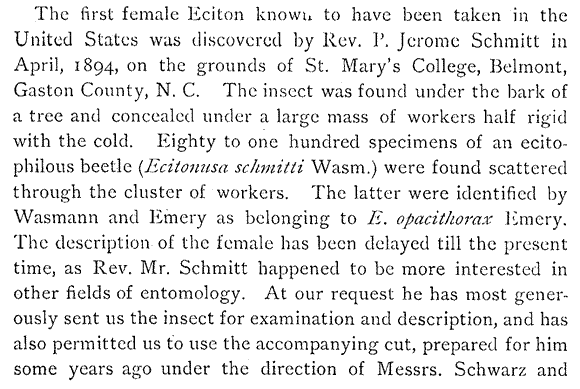
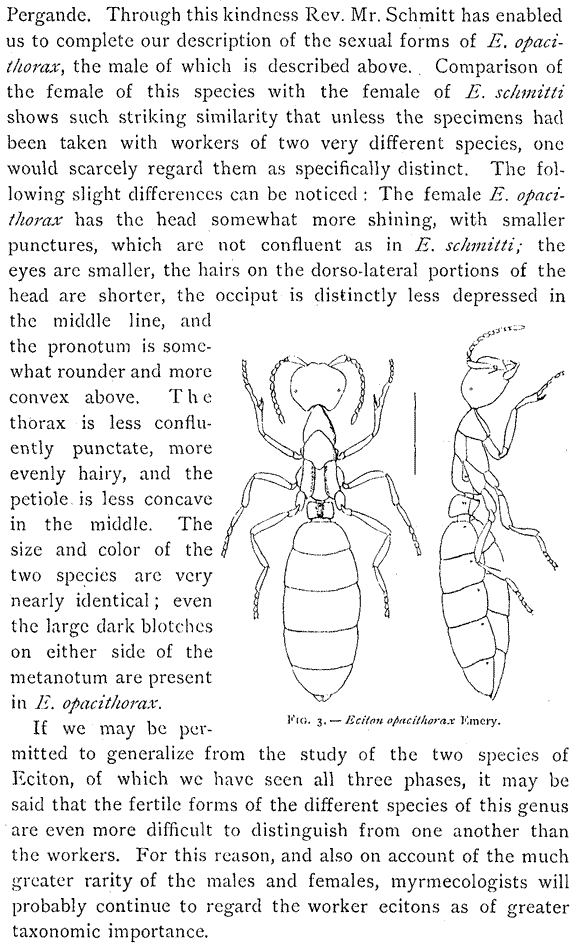

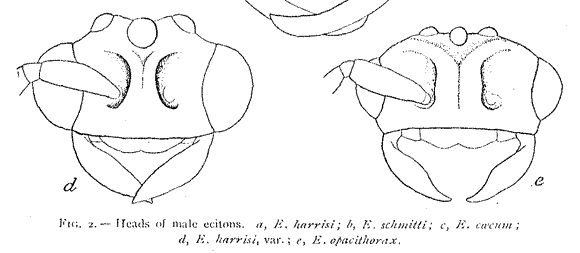
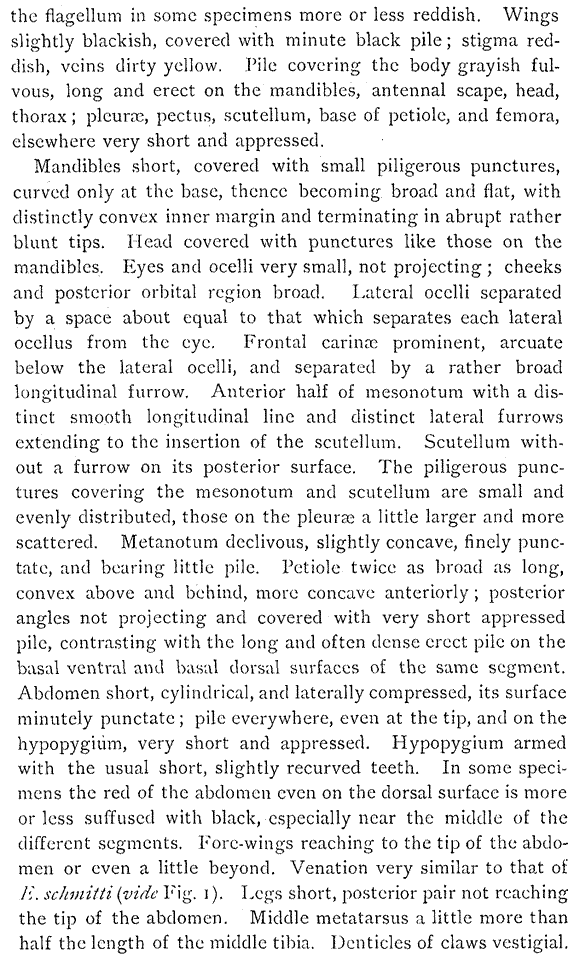

- Literature
- Emery, C. 1894. Studi sulle formiche della fauna neotropica. VI-XVI. Bullettino della Societa Entomologica Italiana. 26:137-241, Tav I-IV.
- Snelling, G. C. and R. R. Snelling. 2007. New synonymy, new species, new keys to Neivamyrmex army ants of the United States. Pages 459-550 in R. R. Snelling, B. L. Fisher, and P. S. Ward, editors. Advances in ant systematics (Hymenoptera: Formicidae): homage to E. O. Wilson - 50 years of contributions. Memoirs of the American Entomological Institute, vol. 80, Gainesville, FL, 690 p.
- Rettenmeyer, C. W. 1963. Behavioral studies of army ants. University of Kansas Science Bulletin. 44:281-465.
- Watkins, J. F., II. 1985. The identification and distribution of the army ants of the United States of America (Hymenoptera, Formicidae, Ecitoninae). Journal of the Kansas Entomological Society. 58:479-502.
- Wheeler, W. M. and W. H. Long. 1901. The males of some Texan Ecitons. American Naturalist. 35:157-173.
- A note about these publications. The literature cited here is not meant to be an exhaustive list of papers published about this species.
Page authored by David Lubertazzi and Gary Alpert
